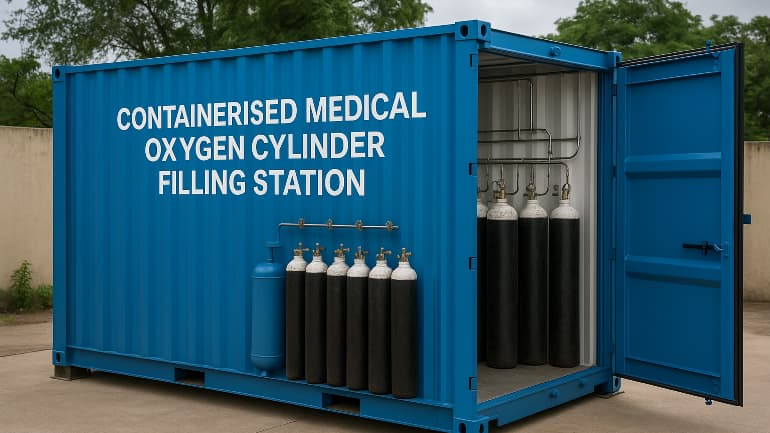India’s oxygen infrastructure needs urgent revitalization with decentralized, containerized filling stations and a National Oxygen Grid. Public-private partnerships and trained personnel are vital to ensure life-saving, reliable oxygen supply nationwide.

In a month, two incidents of deaths, one in Karnataka and another in Punjab, were reported due to a shortage of medical oxygen. Many such incidents are unreported and go unnoticed. Reason: Defunct Medical Oxygen Infrastructure.
When COVID-19 struck, India moved with urgency to commission thousands of PSA medical oxygen generators and liquid medical oxygen (LMO) tank units across the country. The nation intended these installations to serve as its safety net. But today, the majority of them are defunct beyond repair to deliver medical-grade oxygen, plagued by poor maintenance, operational gaps, and a shortage of trained personnel.
Covid lurking around and revisiting often has stoked the directives from the Health Ministry to conduct mock drills in government hospitals. This ritual has revealed a sobering truth: Most PSA systems are unable to deliver oxygen of medical grade, and in some cases, they are supplying nothing more than compressed air. Without sustained usage and regular servicing over the past three years, the country’s oxygen infrastructure has slipped into disrepair. Health ministry officials admittedly are seeking a dependable solution to ensure all-time preparedness.
Lessons from the Pandemic
Decentralized oxygen infrastructure (independent captive oxygen cylinder filling stations at every district & sub-district level) to prevent the migration of patients from villages to cities. Secondly, strengthening of medical oxygen infrastructure in ensuring last-mile delivery till the last village & the last patient at home can be ensured only through the indispensable medical oxygen cylinders.
Why Adding Oxygen-Generating Capacities Alone Won’t Solve the Problem
It is important to understand that oxygen-generating systems can be installed only in big hospitals, which essentially have medical gas pipeline systems. This segment caters to less than 20% of our population and only in big cities & towns. Studies have revealed that during Covid, the majority of the deaths have happened in rural India. India’s rural areas, home to nearly 65% of the population, remain especially vulnerable and are totally dependent on oxygen cylinders.
Cylinders save more lives!! This was best reflected during Covid when the Gurudwaras in Delhi and Punjab conducted oxygen langars by refilling smaller cylinders from bigger cylinders. This justifies commissioning independent containerized medical oxygen cylinder filling stations at every district headquarters.
Currently, the absence of such local refilling facilities at district and subdistrict centers forces patients or hospitals to transport cylinders over long distances, often during critical hours. This is where decentralization becomes not just a logistical improvement but a matter of life and death.
Containerized Cylinder Filling Stations: Rapid response; answer for ensuring all-time preparedness.
Establishing containerized medical oxygen cylinder filling stations at every district headquarters is emerging as a viable strategy to guarantee uninterrupted supply and emergency readiness.
Built as mobile-compatible modules, they can be relocated or scaled up during crises, ensuring oxygen reaches even Primary Health Centres (PHCs) without delay. Continuous operation prevents the idle deterioration seen in many PSA plants while maintaining a consistent supply chain throughout the year. These container modules can be very well integrated with existing healthcare infrastructure to provide last-mile delivery of oxygen.
Proponents highlight that such stations can lower logistics costs, enhance supply reliability, and keep states prepared for emergencies & disaster management, while also meeting routine healthcare demands effectively.
Call for National Medical Oxygen Grid to Strengthen Healthcare
CPDMED, IISC Bangalore, has designed the National Medical Oxygen Grid. India’s healthcare infrastructure could benefit from a connected oxygen grid to ensure uninterrupted availability, all-time accessibility, consistent quality, and fair & uniform pricing across the country. A suggested framework for a National Medical Oxygen Grid outlines setting up containerized filling stations in each of the nation’s 780-plus districts, located near existing drug and vaccine warehouses for logistical efficiency.
The concept includes the use of AI-based analytics, geospatial mapping, and a hub-and-spoke delivery model to optimize routes and reduce delays. Round-the-clock supply would be maintained under strict quality standards, with prices regulated by the Drug Price Control Order (DPCO).
A single toll-free number would allow hospitals and health centers to request refills, enabling swift response during emergencies.
Corporate Participation Can Accelerate the Mission by Corporate Adoption of a District/Several Districts
Typically for an hour, a patient would spend anywhere from Rs.50 to 350 per hour, which many underprivileged patients at home in both urban & rural India cannot afford. Ironically, we are not ensuring the fundamental right to life. If corporate entities would adopt just one district, public-private partnerships would strengthen India’s oxygen security and bring in transparency & accountability, making this grid a reality.
Training for Sustainability
No matter how advanced the equipment, it will fail without skilled operators and regular upkeep. Training healthcare workers in the operation and maintenance of oxygen systems is vital to ensuring this infrastructure delivers when it matters most—a priority for the skill development ministry.
From Crisis Response to Long-Term Readiness
By adopting decentralized containerized filling stations and connecting them through a National Medical Oxygen Grid, India can move from reactive measures to a proactive, future-ready system that saves lives every day, not just during emergencies. This grid would serve the underprivileged well and add dignity to lives.
By continuing you agree to our Privacy Policy & Terms & Conditions
